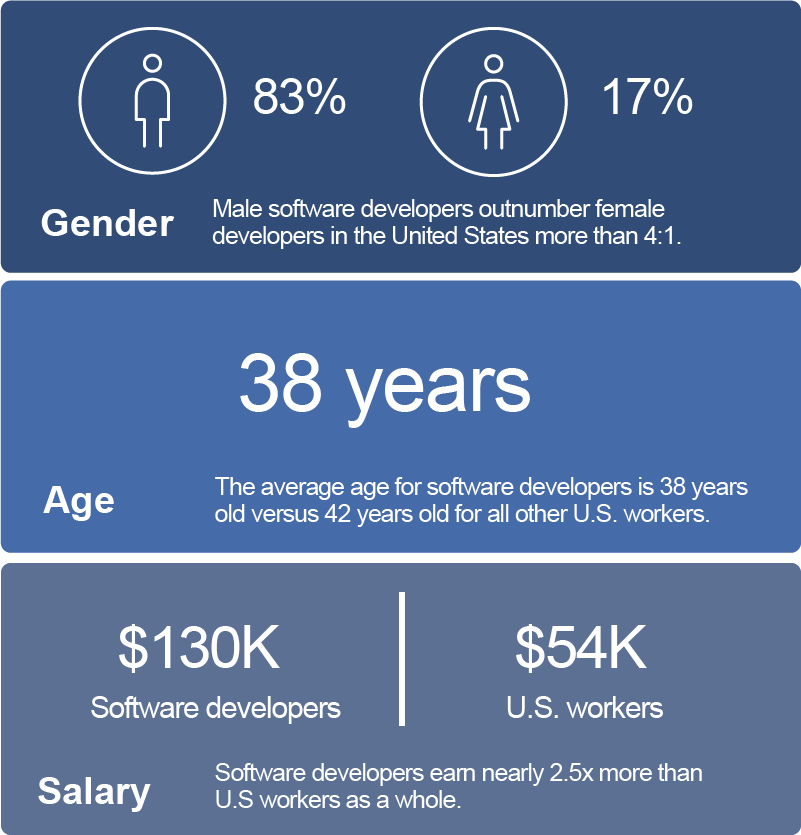Since the rise of the internet, software developers have commanded big salaries and valuable perks. But something has shifted since the pandemic, and the U.S. now employs fewer software developers than it did in 2018.
Consumer spending on digital goods and services ramped up during the pandemic to accommodate stay-at home workers and families, a shift that jolted U.S. demand for tech workers. By 2023, that wave of hiring was met with reductions in force as employers laid off software developers and engineers.
But employment of software developers in fact has been slowing since 2020, the year pandemic lockdowns first hit the United States. In January 2024, the U.S. employed fewer software developers than it did six years ago.
The data in detail
Software developers design, build, and test software for applications and systems. More than half are employed in the professional and business services sector. Another 16 percent work in the information sector.
The ADP Research Institute tracked employees at 6,500 companies, including more than 75,000 software developers and engineers in 10 industries, between January 2018 and January 2024. Using this data, we built an index to track the employment of software developers beginning in January 2018.
Developer employment grew from January 2018 to November 2019, then began to fall. The index dropped sharply in January 2022 (down 4.6 percentage points), May 2022 (down 3.5 percentage points), and January 2023 (down 3.4 percentage points). Despite intermediate increases in August 2021 and October 2022, the developer employment index has been falling since 2020.
As employment has fallen, pay growth has lagged that of total U.S. workers. Between January 2018 and January 2024, the median base pay for developers grew by 24 percent while pay growth for total U.S. workers grew 30 percent. Still, developers remain well compensated, earning more than two times the U.S. median salary.
A regional look
The Cleveland-Akron-Canton region in Ohio has the lowest pay for software developers, who earned a median pay of $78,000 a year in 2018. Salaries in this region grew by 27 percent to more than $100,000 in 2024.
The highest-paid software developers work in Silicon Valley and the greater Bay Area of San Jose-San Francisco-Oakland, earning a median $163,200 in 2024. This region also had among the slowest growth in median pay of all U.S. combined statistical areas, at 18 percent.
This slowdown in pay might indicate cooling demand for developers. Or it could be a symptom of geographical trends in the workforce.
The regions with the biggest growth in median pay for software developers were Utah’s Salt Lake City-Provo-Orem and Florida’s Orlando-Deltona-Daytona Beach, each at 35 percent. Both areas have documented an influx of tech workers as people flee the high cost of Silicon Valley and the greater Bay Area.
The takeaway
Software developers had a run but opportunities might be waning.
The emergence of artificial intelligence might be reason for the shift, as employers invest in automation. But AI tools also can be a boon to developers by improving efficiency and productivity. Ultimately, regardless of how the work gets done, the function of software developers remains essential to businesses that rely smooth-running systems.
Methodology
The index represents the employment of software developers each month relative to January 2018. To identify software developers in the ADP sample, we independently matched two criteria, job titles and O*NET occupation codes, followed by review and filtering of the results. A set of employees was identified by querying a set of keywords present in known software developer job titles (such as software engineer, C++ developer, stack developer) and querying O*NET occupation codes for software developers (15-1252.00, 15-1253.00, 15-1254.00 and 15-1221.00). Combined data resulting from these queries was manually reviewed to weed out any job titles captured erroneously. Because the list of resulting job titles was quite long, a rule of thumb was applied to job titles that occur fewer than 2,500 times. These had to contain the key words “software” or “developer” to be included in the sample.





